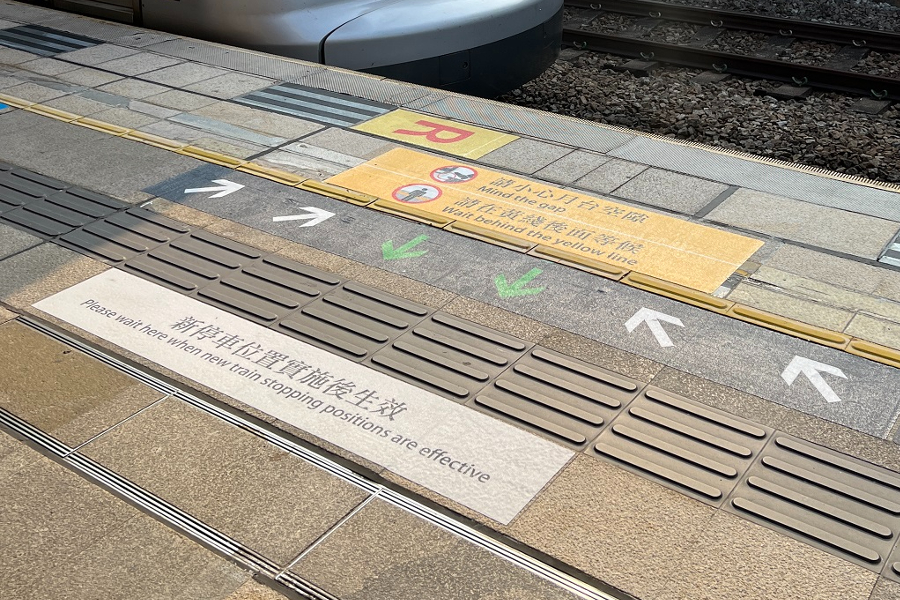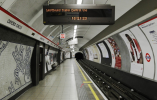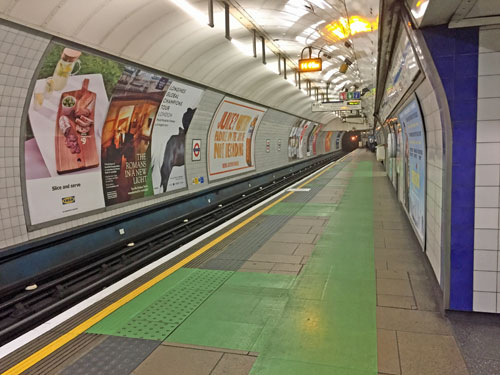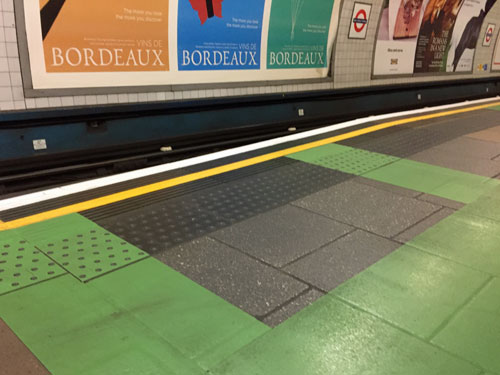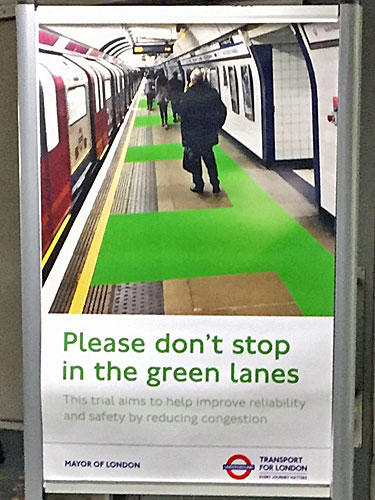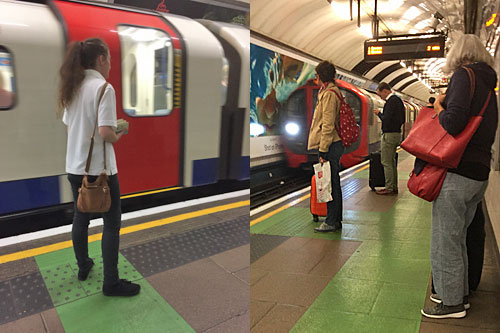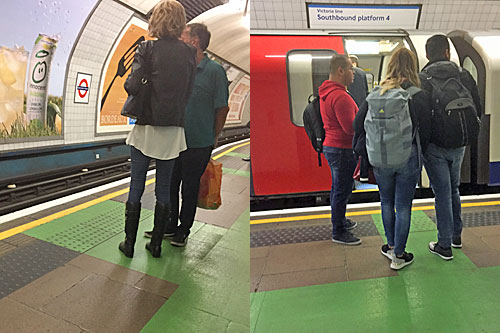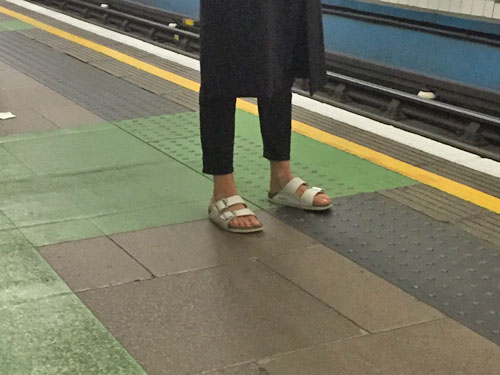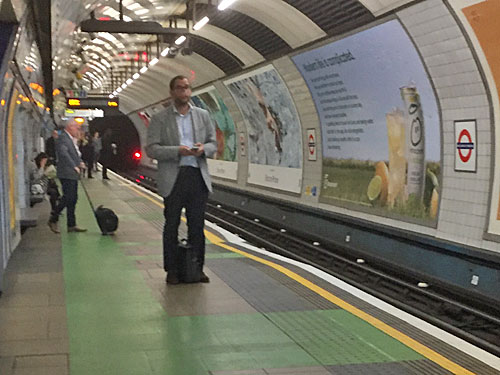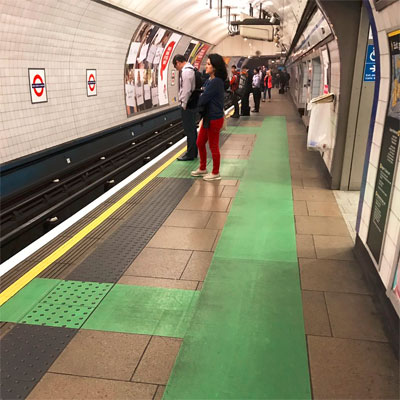This is the southbound Victoria line platform at King's Cross St Pancras.
The green bits are new.
Instinctively, what do you think the green bits mean?
And if you stop and think a bit harder for a few seconds, what do you think they mean now?
Well...
The green bits are part of a
trial which aims to reduce congestion on the platform.
Green lanes trial
A trial to reduce crowding and the time trains spend at platforms is due to go on trial at King's Cross in 2017. Aiming to change customer behaviour on platforms, if successful it will improve passenger flow, reduce congestion and therefore enable us to run more trains per hour, providing greater capacity on the network.
The
trial started last week, and is due to continue for "up to three months". But have you worked out what's going on yet?
When customers gather at platform entrances and train doors it can make boarding and alighting difficult, and can lead to bottlenecks. The green lanes trial looks to solve these problems, and ease the high levels of congestion created as a result.
So yes, it's all about directing waiting passengers to stand in some places and not others.
But are you supposed to wait in the green bits, or not wait in the green bits?
This poster spills the beans.
The green bits are "green lanes", and they're for
not stopping in.
Green vinyl areas on the platform floor will encourage people not to stop in certain places.
The idea is that those waiting on the platform keep out of the way of passengers alighting from trains,
and provide a clear lane at the rear for exiting the platform. Essentially this is 'Please stand away from the doors and allow passengers to get off', writ large.
The trial will clearly differentiate the walking and waiting areas on platforms by creating green vinyl lanes that run the whole length of the platform, and spur off to the train doors. The non-green areas become the customer waiting areas. The dedicated moving area created by the green lanes will improve the flow of customers getting on and off the train and entering and leaving the platform.
But you can guess what's been happening.
People are standing in the green bits.
Lots of people are standing in the green bits.
There are several possible reasons for this.
Firstly there's only one poster explaining what to do, way back at the top of the escalator leading down from the ticket hall. If you don't see the poster, or come in via a different route, or have forgotten which way round the green bits work by the time you reach the platform, you're left to make up the rules as you go along.
Secondly, green is the internationally recognised colour of 'Go'. At street level green means approval to proceed, so a lot of people are assuming that the green bits are where they're meant to be. You can see why it's tempting to stand on green, especially when there's no train in the platform to show you've got things round the wrong way.
But the green lanes are really for passengers
alighting from the train, to provide a swift and easy pathway out. It makes perfect sense that they're green when viewed that way. But green doesn't work so well for those hanging around waiting, who are left to deduce they can stand everywhere that isn't.
Thirdly, a lot of people have assumed, correctly, that the green bits show where the doors are going to be. Hurrah, they think, if I stand here I'll be immediately in front of the doors when the train arrives. They recognise this as a convenience, because they're only thinking about themselves, and not the fact that dozens of people will soon be trying to disembark onto the precise spot where they're now standing.
Meanwhile several other people are paying no attention whatsoever to the green bits.
These people simply walk onto the platform and stand where they like, and the colour of the floor beneath their feet is of no interest. These are the people with one end of their shoe in the green lane and the other end out of it, plus maybe a suitcase sprawled across the two. There is no reasoning with the oblivious.
It all gets particularly complicated at the back of the platform, where it's actually quite tricky to stand completely behind the green lane, and most passengers waiting back here don't generally keep clear.
And then, obviously, there are people doing exactly what they've been told and standing in the not-green bits.
Selective use of photos can make it look like everybody's got it totally wrong, whereas in fact several have got it (intentionally or unintentionally) right, as several minutes standing watching confirms.
Most importantly, I should point out that I took these photos in the middle of the day. Between peak hours the platform isn't especially busy, and at these times the green lanes aren't in any way necessary. But TfL's trial is focused very much on reducing congestion in peak hours, particularly the morning crush, and it might work a heck of a lot better then.
I can imagine rush hour commuters standing out of the way, or learning to stand out of the way, and letting their fellow inbound passengers pass. It must be easier to establish a system when there aren't so many one-off tourists around, and when numbers make it easier to observe 'correct behaviour' by example. I could also imagine peak times being an unholy mess as the green lanes are entirely disregarded, but I'm willing to be charitable given I haven't seen the evidence.
Announcements will also be made to remind customers to keep moving.
It appears station staff are making announcements about the green lanes, which'll surely help passengers understand precisely what they mean. I didn't hear a single announcement in the ten minutes I watched, but maybe they restrict them to peak hours when announcements would be relevant and useful, and don't bother wasting passengers' time the rest of the day.
Equalities-wise, a green strip that only makes sense if you can
hear an announcement isn't a great idea. And green isn't a good choice for the colour-blind, especially when there's also a yellow strip on the platform which means something completely different.
Perhaps some vinyl arrows on the green bits would help, showing passenger flow away from the train, although they might simply draw attention to where the doors are and make things worse. Previous experiments with arrows on the Jubilee line didn't seem to work either, so maybe that's why they've not been included here.
Anyway, it's only a
trial at the moment, so let's not fret.
Using CCTV cameras, we will time how quickly passengers get on and off the train, as well as noting if fewer trains are delayed due to overcrowding. For comparison, we have collected data from before the trial, looking at the morning peak. We will study the results of the Green Lane trial before deciding whether this can be introduced more widely.
But my hunch is we won't be seeing this precise set-up rolling out elsewhere. It reminds me of the 'standing only' escalator trial at Holborn, which solved a problem that only exists for a couple of hours a day, hence trying to enforce the rule at other times proved unmanageable. Rules need to be consistent, and seen to be necessary, else stubborn Londoners will always disregard them.
All we appear to have learned so far is that if you paint something green and don't label it, people aren't going to understand what it means.
Twitter, what do you think these trial green markings on the Kings Cross Victoria Line platform are telling you to do?
pic.twitter.com/Wti1hQeqBg
— Martin Belam (@MartinBelam)
July 25, 2017
• OMFG they are so stupidly designed. Don't get me started
@chrisapplegate
• I read them instinctively as "stand on the green, then enter train via the green", but that would make it impossible to move along platform
@LFDodds
• It's where the doors are and where you should leave space for people exiting?
@adebradley
• The internationally recognised colour of forbidden, green.
@PaulFedayn
• First impression - queue here for doors.
@ThatMattSpencer
• After a bit of thinking I think they're showing the people getting off the train their route out, so I shouldn't stand there? But the shapes are very dazzle ship/cognitive overload imho
@adambanksdotcom
• Queue. I am British and assume every line on the ground is somewhere to queue.
@stuartgibson
• Natural instinct would tell you that it's ok to stand there. Knowing what That London is like, I bet it means the exact opposite.
@WelshGasDoc
• My guess is lead you towards doors?
@CJTerry
• Where you shouldn’t stand so you can let people off? Although if that’s the case, it should be red.
@chrisbrandrick
• They're identifying where the doors will open for the next train, which will give a helpful advantage to us - the sighted - over the blind
@adamdickstead
• Leave paths clear to allow people to get off the train, you damn selfish door blocking pigs?
@freudianskippy
• I'd assume that's where the doors were gonna be, but no idea about the long green bit parallel to the track
@build_a_fire
• Like where to stand to be by the doors when they open
@OliverJ0
• The signs say keep clear, the placement and colour say "queue here"
@howlieT
• Green has a strong emotional correspondence with safety. I would be inclined to stand on the green unless I saw people behaving differently.
@LeeAnnEspo
• Are they to help partially sighted people find the doors?
@liquidindian
• I think it sort of means "please dawdle and play on your phone in this shaded area"
@mutablejoe
• Is it 'stand on this unrealistically small portion of the platform only, the rest is lava'?
@IanDouglas
• "Go this way for the District Line"?
@unloveablesteve
• I think it's a cycle lane.
@gredmond76
• Does it mean: You didn't get a garden bridge, so here's our garden platform, but due to driver salary increases, we could only afford paint?
@AndrewDoesSEO
• Walk all along the green. As you do so it will light up. Successfully complete the puzzle and win a prize.
@JonnieMarbLes
• Miniature golf
@mrchimpington
• As a Londoner I dislike this. A LOT. So much so that it made me tut and sigh quietly to myself.
@NathanRyan89
